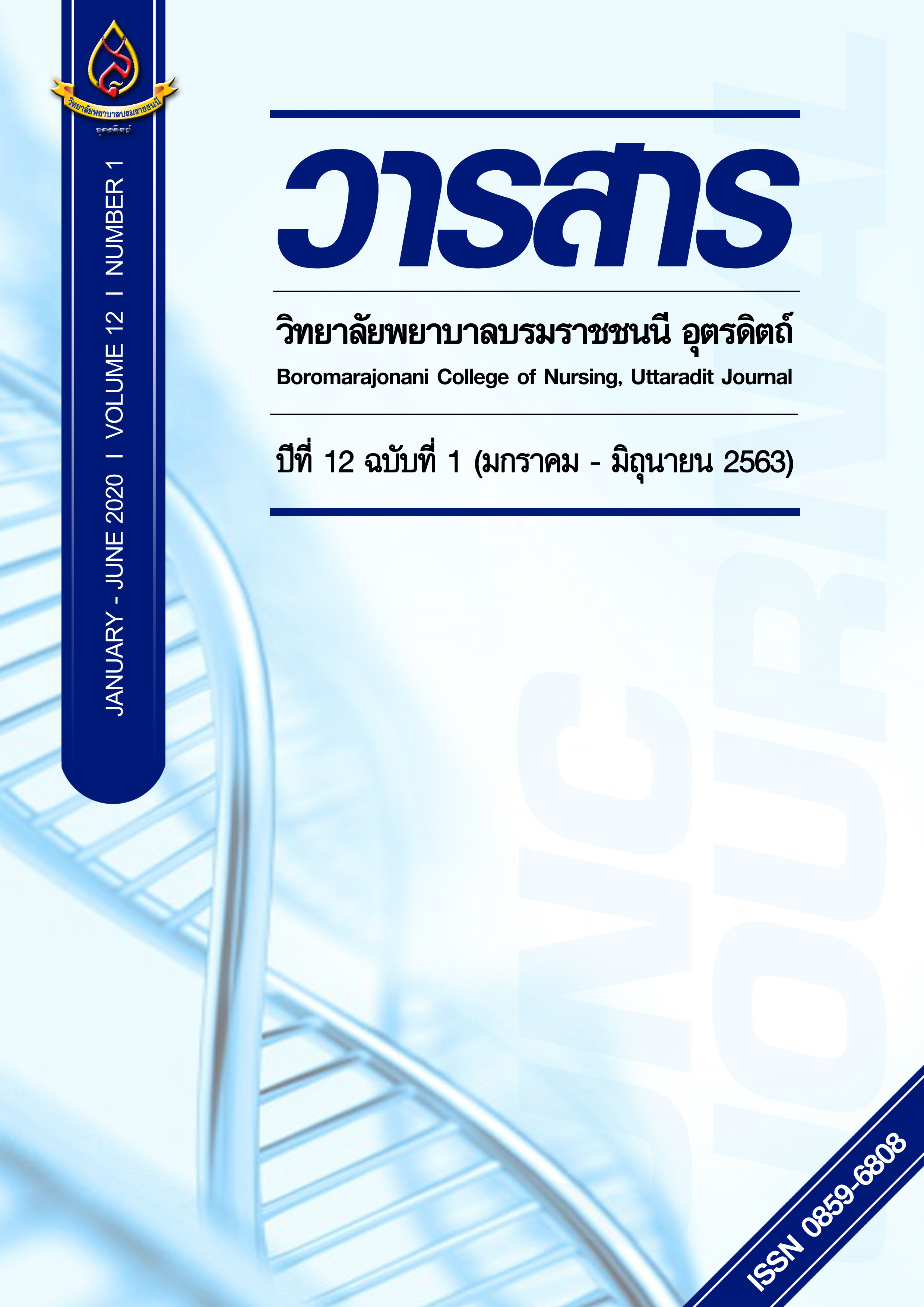ผลของโปรแกรมสื่อเกมคอมพิวเตอร์ “Kid...คิด” ต่อทัศนคติ การรับรู้บรรทัดฐานทางสังคม และการรับรู้ความสามารถในการควบคุมพฤติกรรมเพื่อการหลีกเลี่ยงพฤติกรรมเสี่ยงทางเพศของนักเรียนชั้นประถมศึกษาปีที่ 6
Main Article Content
บทคัดย่อ
การวิจัยกึ่งทดลองครั้งนี้ เป็นการศึกษาผลของโปรแกรมสื่อเกมคอมพิวเตอร์ “Kid...คิด” ต่อทัศนคติ การรับรู้บรรทัดฐานทางสังคม และการรับรู้ความสามารถในการควบคุมพฤติกรรมเพื่อการหลีกเลี่ยงพฤติกรรมเสี่ยงทางเพศของนักเรียนชั้นประถมศึกษาปีที่ 6 โรงเรียนประถมศึกษาแห่งหนึ่งในกรุงเทพมหานคร จำนวน 50 คน โดยใช้วิธีการสุ่มเข้ากลุ่ม 2 กลุ่ม กลุ่มทดลองเป็นกลุ่มที่ได้รับโปรแกรมสื่อเกมคอมพิวเตอร์ร่วมกับการเรียนการสอนตามปกติ จำนวน 27 คน และกลุ่มควบคุมเป็นกลุ่มที่ได้รับการเรียนการสอนตามปกติ จำนวน 23 คน เครื่องมือที่ใช้ในการทดลองประกอบด้วย แผนการดำเนินกิจกรรม สื่อเกมคอมพิวเตอร์ และเครื่องมือที่ใช้ในการเก็บรวบรวมข้อมูล ประกอบด้วย แบบสอบถามข้อมูลทั่วไป แบบสอบถามทัศนคติ การรับรู้บรรทัดฐานทางสังคม และการรับรู้ความสามารถในการควบคุมพฤติกรรมเพื่อการหลีกเลี่ยงพฤติกรรมเสี่ยงทางเพศ ผ่านการหาคุณภาพเครื่องมือด้วยการตรวจสอบความตรงตามเนื้อหาโดยผู้ทรงคุณวุฒิ 5 ท่าน และหาความเที่ยงด้วยค่าสัมประสิทธิ์อัลฟาของครอนบาค(Cronbach’s Alpha Coefficient) มีค่าเท่ากับ .82, .92, .85 ตามลำดับ วิเคราะห์ข้อมูลโดยใช้ สถิติบรรยาย และสถิติการทดสอบแมนวิทนีย์
ผลการวิจัย พบว่า การรับรู้ความสามารถในการควบคุมพฤติกรรมเพื่อหลีกเลี่ยงพฤติกรรมเสี่ยงทางเพศของกลุ่มทดลองแตกต่างกับกลุ่มควบคุม อย่างมีนัยสำคัญทางสถิติที่ระดับ .05 ส่วนทัศนคติ และการรับรู้บรรทัดฐานทางสังคม ไม่แตกต่างกัน
ข้อเสนอแนะ ควรมีการนำโปรแกรมสื่อเกมคอมพิวเตอร์ไปประยุกต์ใช้เป็นสื่อการเรียนการสอนให้กับเด็กและวัยรุ่น สอดแทรกเข้าไปเป็นส่วนหนึ่งของการจัดการเรียนการสอนหรือกิจกรรมเสริมหลักสูตร เพื่อเพิ่มการรับรู้ความสามารถในการควบคุมพฤติกรรมเพื่อการหลีกเลี่ยงพฤติกรรมเสี่ยงทางเพศ
Article Details
บทความหรือข้อคิดเห็นใดใดที่ปรากฏในวารสารวิจัยการพยาบาลและวิทยาศาสตร์สุขภาพ เป็นวรรณกรรมของผู้เขียน ซึ่งบรรณาธิการหรือสมาคมศิษย์เก่า ไม่จำเป็นต้องเห็นด้วย และบทความที่ได้รับการตีพิมพ์เผยแพร่ถือเป็นลิขสิทธิ์ของวารสารวิจัยการพยาบาลและวิทยาศาสตร์สุขภาพ
เอกสารอ้างอิง
2) Ajzen, I., & Fishbein, M. (1980). Understanding attitudes and predicting social behavior. Englewood Cliffs, NJ: Prentice-Hall.
3) Baumler, E., Glassman, J., Tortolero, S., Markham, C., Shegog, R., Peskin, M., & Franks, H. (2012). Examination of the relationship between psychosocial mediators and intervention effects in It’s Your Game: an effective HIV/STI/pregnancy prevention intervention for middle school students. Journal AIDS research and treatment, 10(1), 1-8.
4) Bureau of Reproductive Health. (2017). Reproductive health situation in adolescents and youth in 2016. Retrieved (2017, April 20) from http://rh.anamai.moph.go.th/ download/ all_file/index/RH@2559.pdf
5) Bureau of Reproductive Health. (2013). Prevention and problem solving for teenage pregnancy, Nonthaburi: Ministry of Public Health. Retrieved (2015, February 10) from http://www.rh.anamal.moph.go.th.
6) Duangmahasorn, S., Srisuriyawey, R., Homsin, P. (2015). Effects of positive development program on attitudes toward premarital sex, perceived self-efficacy, and intention to refuse premarital sex among early adolescents. Journal of nursing and education, 8(1), 85-98 (in Thai)
7) Faul, F., Erdfelder, E., Lang, A. G., & Buchner, A. (2007). G* Power 3: A flexible statistical power analysis program for the social, behavioral, and biomedical sciences. Behavior research methods, 39(2), 175-191.
8) Kaewkangwan, S., (2006). Developmental psychology for all ages. (9thed). Bangkok: Thammasat University Press (in Thai)
9) Ministry of Social Development and Human Security. (2014). The situation of children of Thai adolescents 2013. Bangkok: Ministry of Social Development and Human Security. Retrieved (2017, April 20) from http://www.childpregnancy.m-society.go.th
10) National Statistical Office. (2011). Survey of smoking and alcohol drinking behavior of the people. Retrieved (2017, April 20) from http://service.nso.go.th/nso/nso_center/project/search_center/ 23project-th.htm
11) Neranon, W., Rutja, P., Chuanruedee, K. (2018). Effects of the activity package computer game media on attitudes, norms and perceived behavior control on sexual abstinence of 7th grade students. Kuakarun Journal of Nursing, 25(1), 73-89 (in Thai)
12) Puntang, P., Toonsiri, C., & Junpraasert, S. (2014). Factors influencing intention to prevent sexual risk behaviors of female secondary school Students under the department of general education, the secondary educational service area office 2 in Chonburi Province. (Master’s thesis). Community Medical Nursing Program, Faculty of Nursing, Burapha University) (in Thai).
13) Ratanaphan, P., (2009). Synthesis of research on prevention and reduction of sexual risk behavior programs in adolescents. (Master’s thesis) Mental Health and Psychiatric Nursing of Graduate School, Mahidol University) (in Thai).
14) TaiKhanong, K. (2011). Factors influencing intention to have sexual risk behavior of secondary school students. Christian University Thailand of journal, 17(1), 168-177 (in Thai).
15) Thipwareerom, W., Powwattana, A., and Lapvongwatana, P., (2013). Factors used to predict sexual risk behavior of male adolescents Phitsanulok Province. Thai Public Health Nurses Association, 27(1) (in Thai).
16) Trasoo, S., (2007). Sexual risk behavior of adolescents and self-defense in Khon Kaen province. (Master’s thesis) Community Nursing Branch. Khonkaen University). (in Thai).
17) Tripathi, S., (2011). Know the whole child and heart: the development of children and adolescents. Nakornpratom: Thai Health Promotion Foundation. (in Thai).


